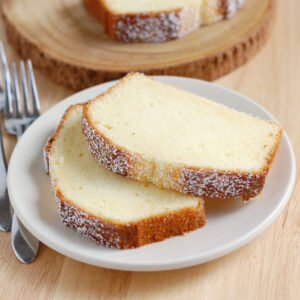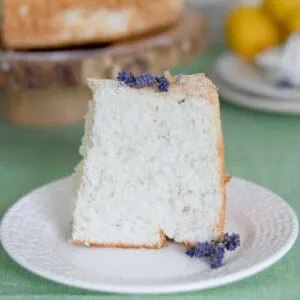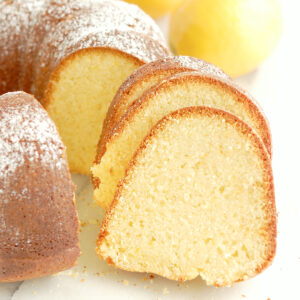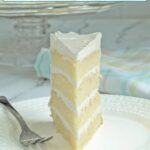🎂 Your Guide to Baking The Best Cakes
Before I started Baking Sense, I owned a custom cake business for more than ten years and baked thousands of cakes for weddings, birthdays, and celebrations of every kind. That hands-on experience taught me how ingredients, technique, and even small adjustments can change everything about a cake’s flavor, texture, and structure.
This Cake Baking Guide brings together the lessons I learned in the bakery and everything I’ve explored since; the science, methods, and techniques that make home-baked cakes tender, flavorful, and reliably consistent. Whether you’re learning the basics or refining your skills, you’ll find clear explanations, practical tips, and dependable recipes to help you bake with confidence.

Table of contents
🍰 Understanding Cake Types & Mixing Methods
All cakes fall into two broad families: butter cakes and sponge (or egg-foam) cakes. The main difference is how the batter traps air: butter cakes incorporate air when butter and sugar are creamed together, while sponge cakes rely on whipped eggs for structure and lift. Understanding this difference will help you choose recipes intentionally and adjust them to get the texture you prefer.
Butter Cakes
Butter cakes begin by beating softened butter and sugar together to incorporate air (creaming). The structure of a butter cake is mostly formed by the flour and eggs. This family includes yellow cakes, chocolate cakes, pound cakes and many layer cakes. Their texture ranges from plush to dense depending on the exact balance of ingredients and how they’re mixed.
- Creaming Method → Produces volume and an open, tender crumb.
- Reverse Creaming Method → Produces a fine, velvety crumb and flat layers ideal for decorating.
Learn more about Creaming vs. Reverse Creaming here →
Sponge & Egg-Foam Cakes
Sponge cakes are built by whipping whole eggs or egg whites to incorporate air before folding in flour and fat. The egg proteins contribute most of the structure for these cakes. This family includes chiffon, genoise, angel food, and roulade cakes. They are lighter and more elastic than butter cakes.
- Foaming Method → Whip whole eggs or yolks + sugar to create structure.
- Chiffon Method → Combines whipped eggs with oil for a tender, cloud-soft crumb.
Oil-Based Cakes
Oil-based cakes can be closer to butter-style cakes or may be a hybrid between butter and sponge cakes. But they do have specific characteristics. Oil remains liquid at room temperature, giving cakes a softer, more plush texture that stays moist for days.
🧑🍳 Cake Baking & Decorating Techniques
Good cake results come from how you handle the batter and layers just as much as the recipe itself. These step-by-step technique guides walk through preparing pans, testing for doneness, assembling and icing cakes, and storing them properly. The more you repeat these small skills, the more natural they become—and the more reliably your cakes will turn out.
If you’d like to practice folding egg foams, Angel Food Cake is the best place to start before moving on to chiffon or genoise-style cakes.
- How to Prepare Cake Pans
- How to Assemble a Layer Cake
- How to Ice a Cake
- How to Cover a Cake with Fondant
- How to Store and Freeze Cakes
🧾 Cake Troubleshooting
Even experienced bakers have cakes that don’t turn out as expected. Small changes in ingredients, temperature, mixing, or timing can affect the final result. Instead of guessing what went wrong, use the guide below to diagnose the issue and understand what to adjust next time.
A dry cake isn’t always caused by overbaking. Most often it comes from an unbalanced recipe, specifically, too little sugar, fat, or liquid relative to the flour. Sugar and fat tenderize the crumb and help retain moisture, so if the proportions are off, the cake will bake up dry even when timed correctly. Using too large a pan can also thin the batter and cause faster moisture loss.
Next time:
Check that the recipe has a balanced ratio of flour : fat : sugar : liquid.
If you’re developing or adjusting a recipe, this page explains how those ratios work:
→ How Cake Recipes Work
And yes — still start checking for doneness a few minutes early. But the root cause is often structure, not timing.
A dense or gummy cake usually means the cake didn’t build enough structure during mixing, either the batter didn’t hold enough air, or the fat and liquid didn’t emulsify properly. Without a strong, stable emulsion, the crumb can bake up heavy, wet, or paste-like, even if the flavor is good.
Most common causes:
Butter and sugar weren’t creamed long enough → not enough air incorporated
Ingredients were too cold → the fat didn’t emulsify with the liquid
Leavening was insufficient or expired → not enough lift
The cake was under-baked → starches didn’t fully set before the structure collapsed
Next time:
Cream butter and sugar until significantly lighter and increased in volume
Make sure eggs, milk, and butter are all room temperature before mixing
Check freshness of baking powder/soda (they lose strength faster than most people realize)
Bake until the center is set and the top springs back lightly when touched
To understand how emulsions and aeration work in cake structure:
→ Cake Mixing Methods
A cake sinks when the structure sets too slowly to support the rise. The batter rises (from air + steam + leavening), but the starches and proteins haven’t set yet, so the center collapses as it cools.
Most common causes:
Under-baking → the middle wasn’t fully set before the cake came out of the oven
Oven temperature too low → the cake rises before the structure can strengthen
Too much leavening → the cake inflates quickly and then falls in on itself
Over-aerated batter → especially from over-creaming or vigorous beating after flour is added
Next time:
Use an oven thermometer to confirm the actual temperature
Avoid opening the oven for the first 20 minutes
Cream butter and sugar until fluffy — but mix gently once flour is added
Test for doneness in the center (not just the edges) before removing from the oven
If a cake sinks only slightly in the center, the flavor will still be good — it’s simply a sign the structure needed a bit more time or support.
A too hot oven can cause the cake to dome at the center because the sides of the cake bake faster than the center. The center continues to rise after the sides are set and a dome forms. If you have too much batter in the pan it will force the center of the cake up and form a dome.
Next time:
Use an oven thermometer to ensure you bake at the correct temperature, use bake-even strips (or damp towel strips), fill pans 2/3 full. Deep pans benefit from a metal flower nail in the center for even heat. Trimming is always an option.
🍮 Recommended Cake Recipes
These recipes highlight the main cake families in this guide. Each type has its own texture and mixing method — choose the style you’re in the mood to bake, or explore across families to see how structure and method shape the crumb.
Butter Cakes

Soft, tender cakes made by creaming butter and sugar to incorporate air. These are the most traditional layer cakes and a great place to begin.
Sponge & Egg Foam Cakes

Cakes that get their structure from whipped eggs rather than beaten butter. Light, airy, and springy — a good place to practice folding and texture awareness.
Oil Based Cakes

Cakes that use liquid oil instead of butter, resulting in a plush, moist crumb that stays soft for days. These are very forgiving and great for everyday baking.
Take your Skills Further

Once you’re comfortable with mixing and baking cakes, you can explore recipes that include layering, filling, or finishing techniques. These cakes are wonderful projects for when you want to spend a little more time in the kitchen or bake for a special occasion.
🧂 More Cake Resources
Keep learning with these detailed baking science and technique pages.
- Cake Recipe Science
- Baking Techniques & Skills
- Baking Tools & Equipment
- Additional Helpful Resources
Explore more in the Baking School or check out the Bread Baking Guide for another foundational baking skill.


